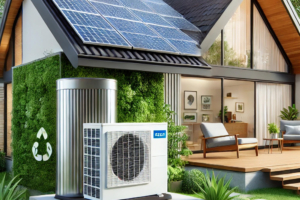Sustainable HVAC Solutions: Green Choices for Your Home
 With environmental concerns taking center stage, many homeowners are seeking ways to make their homes eco-friendlier. One significant area where you can make a substantial impact is your heating, ventilation, and air conditioning (HVAC) system. Modern advancements have made it possible to have a comfortable home while reducing your carbon footprint. Let’s explore various eco-friendly HVAC options that can help you embrace sustainability in your home.
With environmental concerns taking center stage, many homeowners are seeking ways to make their homes eco-friendlier. One significant area where you can make a substantial impact is your heating, ventilation, and air conditioning (HVAC) system. Modern advancements have made it possible to have a comfortable home while reducing your carbon footprint. Let’s explore various eco-friendly HVAC options that can help you embrace sustainability in your home.
Why Choose Eco-Friendly HVAC Systems?
Before diving into the specifics, it’s essential to understand why choosing an eco-friendly HVAC system is beneficial:
- Energy Efficiency: Eco-friendly HVAC systems are designed to use less energy, which can lead to significant savings on your utility bills.
- Reduced Carbon Footprint: By using less energy, these systems emit fewer greenhouse gases, contributing to a healthier planet.
- Improved Indoor Air Quality: Many sustainable HVAC options also improve indoor air quality, which is beneficial for your health.
- Government Incentives: There are often tax rebates and incentives available for installing energy-efficient systems.
Types of Eco-Friendly HVAC Systems
There are several types of HVAC systems that are considered eco-friendly. Let’s explore some of the most popular options:
1. Geothermal Heat Pumps
Geothermal heat pumps are one of the most efficient ways to heat and cool your home. These systems use the stable temperature of the earth to regulate your home’s temperature. During the winter, the heat pump extracts heat from the ground and transfers it into your home. In the summer, it does the reverse, pulling heat from your home and transferring it back into the ground.
- Pros: Highly efficient, low operating costs, long lifespan.
- Cons: High initial installation cost requires sufficient land space for ground loops.
2. Solar HVAC Systems
Solar HVAC systems use solar panels to harness energy from the sun to power your heating and cooling systems. This renewable energy source can significantly reduce your reliance on fossil fuels.
- Pros: Renewable energy source can reduce or eliminate utility bills, environmentally friendly.
- Cons: High initial cost, dependent on sunlight availability.
3. Ductless Mini-Split Systems
Ductless mini-split systems are highly efficient and allow for zoned heating and cooling, meaning you can control the temperature of individual rooms or areas.
- Pros: High efficiency, flexible installation, no ductwork needed, can be used for both heating and cooling.
- Cons: Can be expensive to install, might require multiple units for larger homes.
4. Radiant Floor Heating
Radiant floor heating systems work by circulating warm water through tubes embedded in your floors. This method provides even and efficient heating without the need for ductwork.
- Pros: Even heating, quiet operation, energy efficient.
- Cons: High installation cost works better in new constructions or major renovations.
5. High-Efficiency HVAC Systems
Modern high-efficiency HVAC systems, such as those with Energy Star ratings, use advanced technology to maximize energy use and reduce waste. These systems often include features like variable-speed motors and smart thermostats.
- Pros: Lower energy bills, improved comfort, eligible for rebates and incentives.
- Cons: Higher upfront cost compared to standard systems.
Tips for Making Your HVAC System More Eco-Friendly
Even if you’re not ready to replace your entire HVAC system, there are several steps you can take to make your current system more eco-friendly:
Regular Maintenance: Keep your HVAC system running efficiently by scheduling regular maintenance checks. This includes cleaning or replacing filters, checking for leaks, and ensuring that the system is operating correctly.
- Upgrade Your Thermostat: Installing a programmable or smart thermostat can help you better control your home’s temperature and reduce energy waste.
- Seal Ducts and Insulate: Properly sealed ducts and adequate insulation can prevent energy loss, making your system more efficient.
- Use Ceiling Fans: Ceiling fans can help circulate air, reducing the load on your HVAC system. In the summer, they can make your home feel cooler, and in the winter, they can help distribute warm air.
- Energy-Efficient Windows and Doors: Installing energy-efficient windows and doors can help keep your home at a comfortable temperature and reduce the load on your HVAC system.
Conclusion
Embracing eco-friendly HVAC options is a great way to make your home more sustainable. Whether you choose to install a geothermal heat pump, solar HVAC system, ductless mini-split system, or radiant floor heating, there are plenty of options available to suit your needs and budget. Additionally, simple steps like regular maintenance, upgrading your thermostat, and sealing ducts can make a big difference in your system’s efficiency.
At Jacobs and Rhodes, we are committed to helping you find the best HVAC solutions for your home. Contact us today to learn more about our eco-friendly HVAC options and how we can help you create a more sustainable living environment. Together, we can make a positive impact on our planet while enjoying the comfort of an efficient and eco-friendly home.

 Jacobs and Rhodes
Jacobs and Rhodes Jacobs & Rhodes
Jacobs & Rhodes